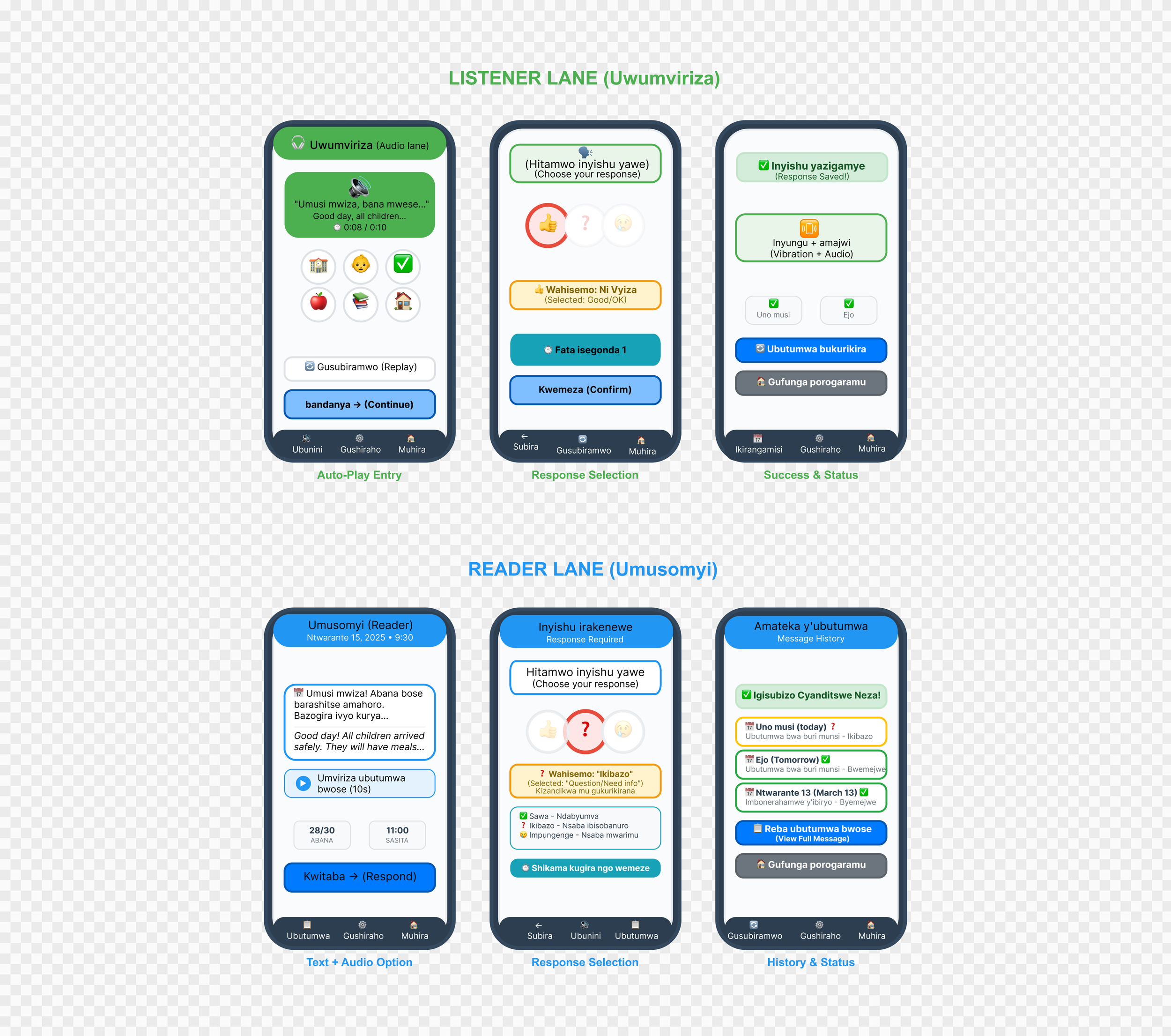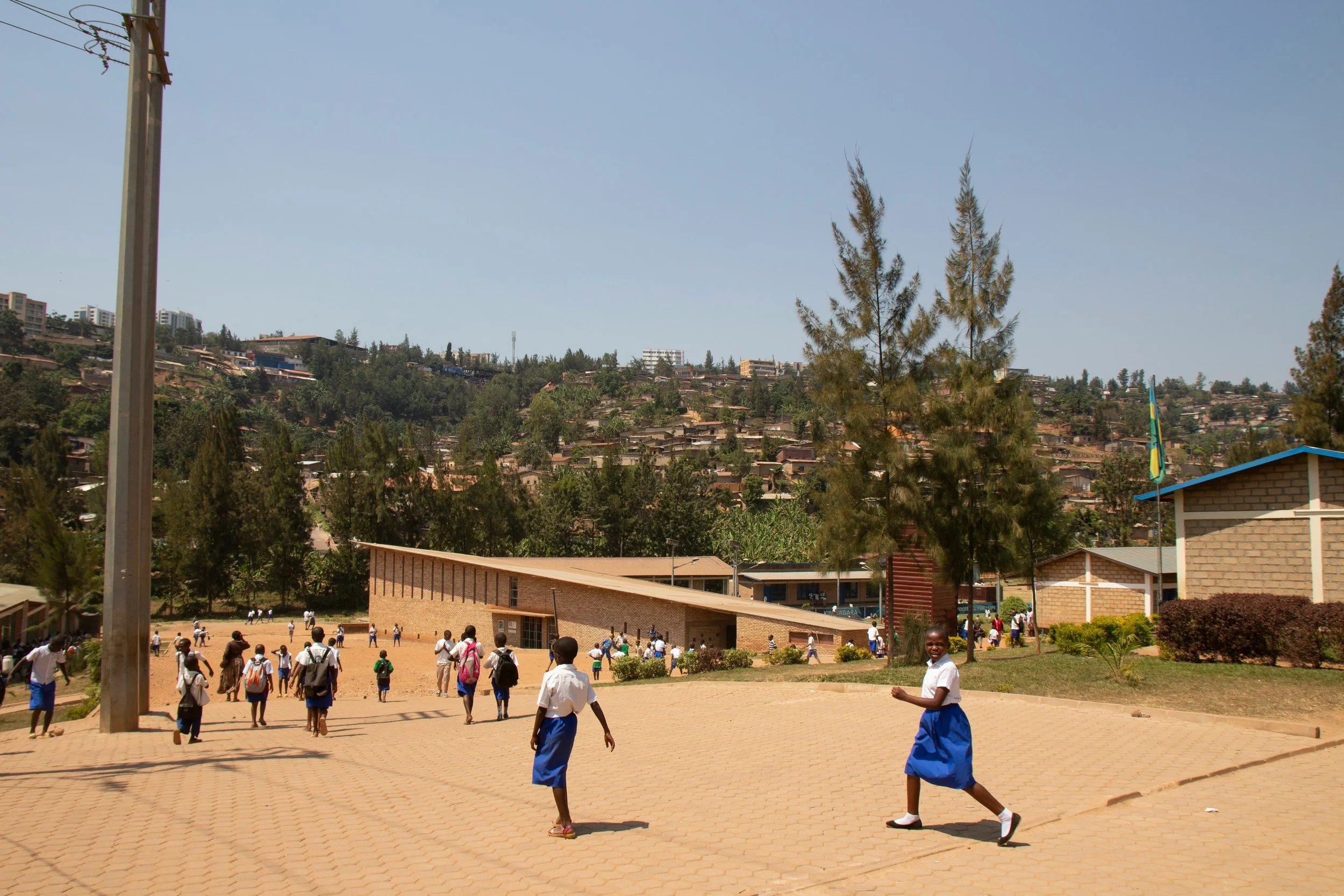
School-Parent Communication App
Bridging literacy gaps for guardians receiving school updates
Role
UX/UI Designer & Researcher
Timeline
4 Months (research to lo-fi prototypes)
Scope
User research, information architecture, interaction design, lo-fi prototyping
Problem
Guardians/parents with unequal literacy need simple, near-zero-data way to receive and acknowledge daily school updates in Kirundi.
What I did
Researched guardian communication needs, designed dual-track user experiences for audio-first (low literacy) and text-first (higher literacy) parents, created lo-fi prototypes with hold-to-confirm acknowledgment patterns, and defined technical requirements for near-zero-data deployment via Bluetooth sideload.
Outcome
A validated concept and lo-fi prototype demonstrating how parents with different literacy levels can receive, understand, and acknowledge daily school updates in Kirundi. Project paused at prototype stage due to funding constraints, but design approach proven viable.
“If we could have an update everyday about their development in their schools, we as parents would better supervise our children and be more involved in their education.”
— Parent interview, Bujumbura, field notes
The Process and Outcome
The challenge was designing a school communication system where guardians/parents have unequal literacy and time but both need to receive, understand, and acknowledge daily updates about their children in Kirundi language first.
-
Deep dive into guardian communication barriers in Burundian school context. Identified two distinct parent personas: time-poor guardians preferring audio updates vs. literate parents wanting text summaries with audio backup.
-
Developed parallel guardian journeys for receiving daily 10-second school updates. Created unified information architecture where both audio-first and text-first parents can acknowledge receipt effectively.
-
Designed for near-zero-data constraint with offline-first architecture, 7-day caching, and £0 deployment via Bluetooth sideload. Optimized for low-end Android devices common in target demographic.
-
Created lo-fi prototypes with hold-to-confirm acknowledgment, pictogram navigation for low-literacy guardians, and emoji-based feedback system. Designed for high-stress parenting contexts
-
Tested lo-fi prototypes with target guardian groups. Validated dual-interface approach but project paused due to funding constraints before high-fidelity development.
User Personas
Understanding Burundian guardians' diverse communication needs
-
42 years old Farmer (3 children)Basic smartphone user. Prefers audio over reading. Shares phone with family.
-
• Works long hours in fields (6am-7pm)
• Limited French/English literacy
• Unreliable electricity for charging
• Shared phone with spouse
• Values traditional communication methods -
• Can't read written school notices
• Misses important updates while working
• Feels excluded from child's education
• Worries about children's wellbeing -
• Know children are safe daily
• Understand updates in Kirundi
• Quick acknowledgment while working
• Feel connected to school community
-
35 years old Teacher (2 children)Comfortable with smartphones. Prefers reading but appreciates audio backup. Uses multiple apps.
-
• Busy teaching schedule
• Literate in French, Kirundi, basic English
• Reliable phone access
• Values detailed information
• Needs to coordinate with spouse -
• Information overload from multiple sources
• Can't always listen to audio in classroom
• Wants to keep records of communications
• Needs to share info with spouse quickly -
• Quick text summaries she can scan
• Audio option when needed
• Ability to review past messages
• Efficient acknowledgment system
Audio-first lane (Listener parents)
Designed for time-poor/low-literacy guardians with auto-playing 10-second Kirundi updates, pictogram navigation, spoken feedback, and simple emoji acknowledgment (👍 ❓ 😢).
Text-first lane (Reader parents)
Created for literate guardians wanting quick text summaries with optional audio playback, visual progress indicators, and written status updates with acknowledgment ticks.
Conclusion
Though funding constraints prevented full development, this project demonstrates my approach to inclusive design for diverse user capabilities, constraint-based UX thinking, and stakeholder communication systems. These skills directly apply to Laing O'Rourke's complex multi-stakeholder construction environments.
Key demonstrated capabilities:
• Designing for diverse literacy/skill levels
• Multi-stakeholder communication systems
• Constraint-based design thinking
• Offline/low-connectivity optimisation
• Cost-conscious deployment strategies
• User research in complex environments
Construction & Infrastructure relevance
Designed for time-poor/low-literacy guardians with auto-playing 10-second Kirundi updates, pictogram navigation, spoken feedback, and simple emoji acknowledgment (👍 ❓ 😢).
Construction application
Just as parents need different ways to receive school updates, construction teams need varied communication formats - safety alerts via pictograms for site workers, detailed reports for managers, but unified project tracking and compliance acknowledgment systems.





